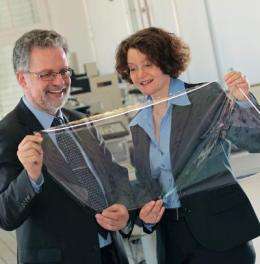Flexible films for photovoltaics

Displays that can be rolled up and flexible solar cells -- both are potential future markets. Barrier layers that protect thin-film solar cells from oxygen and water vapor and thus increase their useful life are an essential component.
What do potato chips and thin-film solar cells have in common? Both need films that protect them from air and water vapor: the chips in order to stay fresh and crisp; the solar cells in order to have a useful life that is as long as possible. In most cases, glass is used to protect the active layers of the solar cells from environmental influences. Dr. Klaus Noller from the Fraunhofer Institute for Process Engineering and Packaging IVV in Freising explains the advantages of a plastic film: "The films are considerably lighter – and flexible. They make new production processes possible that enable significant reductions in the cost of manufacturing a photovoltaic module." Instead of working with individual glass plates, the solar cells could be printed onto a plastic film and then encapsulated with the barrier film: photovoltaic modules on a roll.
That is not a small goal that the researchers from two Fraunhofer institutes want to achieve: The film and packaging developers led by Dr. Klaus Noller along with Dr. Sabine Amberg-Schwab from the Fraunhofer Institute for Silicate Research ISC in Würzburg, who is an expert in hybrid polymers, called ORMOCERs – an in-house development of the ISC. She and her team worked almost 20 years on developing a coating material on the basis of ORMOCER that can be used as an effective barrier against oxygen and water vapor. What has been created is a barrier lacquer that the researchers combined with another known barrier material: silicon dioxide. "The results were astounding," said Amberg-Schwab: "A barrier effect that is far better than could be expected from adding only the two layers. The reason for this are special effects that are generated between the two materials."
For the ideal application on a film, the team in Würzburg developed an ORMOCER coating material that is easy to process and cure. The damp heat test was a particular obstacle: the cured lacquer coating must remain stable at 85 degrees Celsius and 85 percent humidity. The solar cells on the roof or the facade are intended to withstand extreme weather conditions and temperatures as long as possible. The folks from the Freisinger institute faced the challenge of developing a process with which the barrier layers can be applied to the film perfectly and economically.
This was achieved with a roll-to-roll process. The painting line was optimized continuously to meet the special requirements: The ORMOCERs must be applied in a dust-free environment, with the layer thickness being extremely thin, yet as a continuous film. During this, the coated side must not touch one of the rollers at any time. That would damage the layer. The patented process makes it possible to manu facture tough high barrier films in a cost-effective and environmentally friendly way. Industrial partners are already using this process. Dr. Sabine Amberg-Schwab from the ISC and Dr. Klaus Noller from the IVV will receive one of the three 2011 Joseph von Fraunhofer Prizes for their developments.
Provided by Fraunhofer-Gesellschaft


















